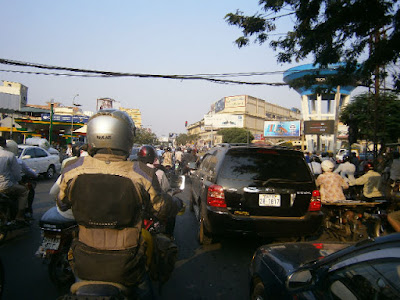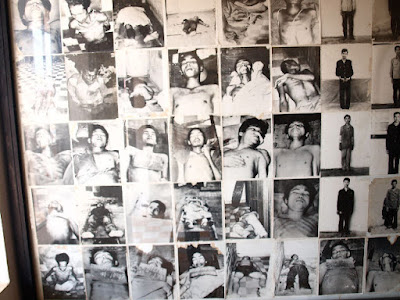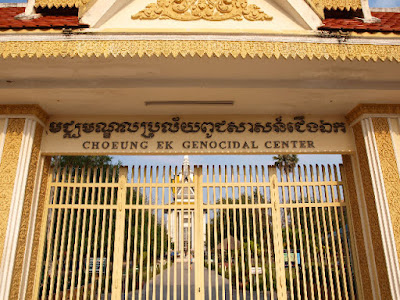So, Cambodian traffic is...fun. Actually it's not very fun at all. Scary would be a better word for it. We realised this while in Phnom Penh. It "only" has a population of 2 million but is much scarier to ride in than Bangkok with its 12 million people. Drivers here are mental! They don't seem to have any notion of road rules whatsoever. There is also a huge lack of traffic lights in the city so most intersections resemble something akin to chaos with traffic coming from all four directions at once! Fun it is...
Phnom Penh is a nice capital city though. It has a real energy to it which is particularly visible at night when all the parks, public squares and water front is packed with locals, playing football or having dinner with their families. As nice as it is, a very dark past lurks in the background. I think I only need to say two words: Khmer Rouge. The Khmer Rouge ruled Cambodia from 1975-1979 and was responsible for a genocide that killed 2 million people through execution, starvation and disease. Their vision was a pure Cambodian society based on strong communist principles. Anyone deemed a threat to this vision was killed. We paid a visit to the Tuol Sleng Genocide Museum, former security office 21 (called S-21). It was set up for the detention, interrogation, torture and killing after confession from the detainees were received and documented. It was an indescribably sad and dark experience walking around these buildings, in and out of rooms where the sounds of prisoners' tortured screams once sounded. The people who were imprisoned here included academics as they were considered to be corrupted by the West and could rise against the Pol Pot revolution, this included doctors, nurses, lawyers, teachers, even people with glasses were persecuted as it was seen as a sign of intelligence. People who for some reason were suspected of leading an uprising against Pol Pot, even some of their own soldiers were tortured and then killed. Whole families were in here and as you walk through the museum you pass by portraits of these people hanging on the wall. It is a mix of men, women and children. They never made it out alive.
After the prisoners had confessed they would be taken to a killing field outside Phnom Penh at the town of Choeung Ek. We went to see this place where 20,000 people vanished. This too was a harrowing place. Trucks would bring prisoners here to be killed. There were many killing fields but this was the biggest; at its peak 300 people a day were killed here. The Khmer Rouge did not wish to waste precious ammunition so people were killed in ways that did not include bullets. Blindfolded, they would be led to a mass grave and made to kneel in front of the hole. A soldier would then smash their skull with a blunt object such as a hammer or an axe and they would be pushed into the grave. You can sometimes see human bones around the mass graves here as the soil gradually subsides. One of the most disturbing things we saw was this one tree. At first sight it looks just like any other tree but then you learn what went on here. You see, many women brought here had little babies. And under the Khmer Rouge rule no one was safe. So the babies were killed too and that's where the tree played a role. The soldiers would rip the babies from their mothers arms, take them by the legs and smash their skulls on the tree trunk. After that they too would be dumped into a mass grave. The horror that went on here is so violent that it's hard to fathom how people could do this to other people. People are still questioning this today; how could this happen? And the worst part - only one person has been sentenced for the part he played in the Khmer Rouge. Pol Pot died while under house arrest in 1998 and the other former generals are all ageing so although a trial is underway it is doubtful whether any of them will live to see themselves sentenced. Nevertheless it is impressive that the Cambodian people have managed to rebuild their country from a devastated mess after the Khmer Rouge was eventually overthrown to what it is today.
The manic Phnom Penh traffic
The waterfront
A UNESCO heritage building
Entrepreneurs set up everywhere on the streets like this tiny barber salon
Tuol Sleng Genocide Museum
Room used for torture
This was used for hanging prisoners upside down until they lost consciousness,
then dunk their head into the jug filled with water, repeat.
Disturbing photos of murdered people
Brother no. 1 aka Pol Pot
So many innocent lives lost, many of them children
One of the cells
Tools used for torture
The Killing Field
The tree with a horrific story
Bone fragments and teeth from the victims






















Hi Sanne and Mark,
ReplyDeleteWe met you in Fraser Hill and the Cameron Highlands and would have written to thank you for that amusing book by Bill Bryson (Austria is a lot better than he makes out) if we had your email address. Really have been enjoying your blog and got some great ideas for future trips but certainly the history of Cambodia is terribly disturbing.
By the way, we read in "The Times of India" that earlier this month a particularly nasty 69 year old character got life imprisonment for his part in the the deaths of at least 12,272 victims from 1975-1979. Why has it taken so long?
If you make it to Siem Reap as we're sure you will, please feel free to introduce yourselves to my cousin Henry who runs the International School there with his Khmer wife. They will certainly be able to provide interesting local knowledge about the area and the wonderful people of Cambodia who have survived.
Cheers
Glyn and Lilly
Hi guys!
ReplyDeleteGreat to hear from you.
That's right, General 'Dutch' has been sentenced to life. He was the guy in charge of the S-21 prison. Why has it taken so long? For a number of reasons I think. One is that the Khmer Rouge was seen as the legitimate government until the 90's I believe, they actually represented Cambodia on the UN council! Other reason is just bureaucracy, Cambodian laws have prevented it from happening any earlier. What more is, it is only the 'top' guys who can be prosecuted, the people who played a smaller role in the movement (even though they might have killed and raped people) will never get punished. So if you ask me, justice certainly hasn't been served.
We did go to Siem Reap but unfortunately didn't have time to visit your cousin. But Siem Reap was lovely, the temples magnificent :)
Hope you guys are doing well back in Perth. Keep in touch!